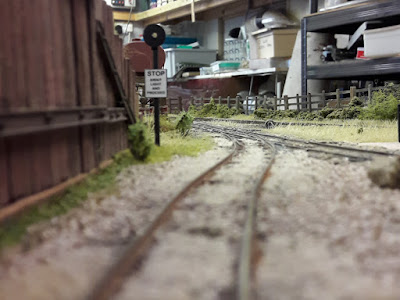Worklist:
Check layout fits in the car.
Check the carrying system works.
'Cable-up' the lighting.
Test lighting.
Prepare notes for setting up the layout.
Fix more things down.
Review the new ticket office.
The first job was to allay any fears about getting to the show. The seats in Geoff's car were dropped to check how much room the layout would take up. Sighs of relief all 'round - bags of room. A final checklist of things to take has not been prepared, but with Stephen taking his car as well, no problems were now envisaged.
We then reviewed the panels Geoff had made to transport the two main boards. Rather than bolt the boards face-to-face (the top board inverted) we had decided to keep them both the same way up. Both ends were installed quite easily using the layout joining bolts, and lifting the assembled unit was not a problem.
A simple tray top will now be made to enable light items to be stacked on top and some side panels to prevent damage to the layouts. The end board already sits on the fiddleyard and takes up little room. Protection will be assessed in due course.
Geoff had been very busy since the last meeting - fitting sockets for cables into the the lighting pole bases, painting the poles, fitting the LED strips into the guttering and wiring them up. Lighting extension cables now need to be inserted into the pipe supports, which was accomplished using a draw-cable. Tee pieces had been fitted into the poles to accommodate the cables out of the bottom.
With the lighting installed, we could see the full effect of the system for the first time and it was impressive. Because each LED strip was separately switched, we could vary the lighting a bit between colours and intensity.
However, Geoff warned that the LED's (which equated to 840w in old money) ran quite hot and was concerned that being fitted to a curved surface, they might not adhere too well. So, when we broke for lunch, the lights were left on to see how they behaved. When we returned, one strip had already dropped down and a few ends were parting company with the gutters.
One solution would be to physically fix the strips in place and another was to find some strong, clear tape to tack them in place. Maybe just the ends needed to be fixed? We'll see.
Geoff returned to preparing small items for painting. Stephen wired-down the wagons on display near the coal staithe fitted the quarry siding yard crane that Geoff had overhauled. Laurence made further alterations to a trestle. Later, Stephen looked for a suitable location for his shed/ticket office. The caravan was originally made for this role, but in making the shed for a 'joke' at his bowls club, it was easily converted to a make-do office, with a shuttered window in the side. A triangular space beside the goods shed looked ideal and was approved. The caravan, being mobile, was better suited in front of the generator room entrance and will now be decorated as the site rest room/cafe.
Stephen had also made a set of A frame advertising panels and put together a selection of adverts. Geoff argued that an embryonic association of that time would have limited funds and aspirations, so advertising material would have been very basic. He will investigate further and produce something more appropriate. The signage and panels for the ticket office being either 'hand made' or generated from real posters can be retained.




























